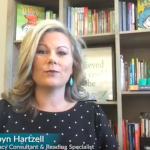5 Tips to Help Teachers Overcome Video Anxiety

Having utilized video-based coaching for many years, I have become used to seeing myself on camera. I admit that, at first, it was kind of nerve-wracking, though. After all, there are professional actors who have stated in interviews that they don’t like watching themselves on film. So, it’s not surprising that there are teachers who are a little nervous about recording and watching themselves. In order to alleviate some of the anxiety, I have found the following tips to be helpful:
- Focus the camera on the students, not the teacher. 🧒
If a teacher is very nervous or hesitant to video themselves, I tell them to place the camera where it will record the students instead. Especially when doing coaching on guided reading, this is actually more helpful for me, as the coach, because I can see how the students are responding and reading. Just knowing that they don’t have to actually be on camera is enough to ease the anxiety of some teachers. - Listen instead of look. 👂
Because self-reflection is such a big part of video-based coaching, I may ask a teacher who has a hard time watching herself to just listen to her video instead. While it’s not exactly the same, there is a wealth of information that can be gained from just hearing what is said and not said during a lesson. - Make it easy. 🥧
For some teachers, the idea of video brings images of complex editing and media software. I try to emphasize to the teachers I coach that the videos they submit do not need to be flawless or look like they have been professionally done. One of the reasons I like the TORSH app is that there is no special equipment needed. They can just set up their phones in the back of the room and hit the record button. Even teachers who have claimed to be “non-techies” were relieved to know the recording process is no more complicated than the push of a button. - Let them choose the video. 🗳️
Before teachers ever submit a video, I make sure that they know they are in complete control of which video they send and who will see it. If they are not happy with how a video turns out, they can do another one. Knowing they are not bound to their first attempt creates a sense of relief for those who may be new to video-based coaching. - Start with a product or a process rather than teaching. ♻️
If a teacher is very nervous about video, I may ask them to upload still pictures, lesson plans or slides, or student work samples instead. Then, I may move on to asking for video of the students participating in the lesson. Maybe they record students collaborating on a project or having student-led discussions. In some cases, I may leave it more open-ended and ask them to record something that shows the student learning in whatever way they think is most reflective of it.
Understandably, the act of recording and viewing themselves on video can be unsettling for some teachers. Most will have their anxiety eased after the first couple of uploads, but some may continue to worry. In those cases, it may be best to reconsider whether video-based coaching is the right vehicle to support the teacher’s development. With some empathetic scaffolds, however, most teachers will be able to overcome their initial anxiety to reap the benefits that recording and reflecting on their practice can provide.

Robyn Hartzell has served in education since 1998 and has experience in a variety of roles: teacher, instructional coach, interventionist, trainer, consultant, and program coordinator at the campus and regional levels. Currently, she works as an independent consultant and coach promoting effective instructional and leadership practices and championing the need for quality professional learning. Robyn takes privilege in coaching professionals in their craft and is passionate about helping organizations develop leaders who make a lasting, positive impact on the programs and people they serve.
Be sure to follow Robyn on Twitter @robynhartzellpd and check out her website at www.hartzellpd.com



